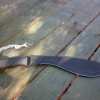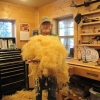Let's go! Cooking up your wax polish.

| 30 October 2019 20:29
Marie-anne - Although it's sticky for a while after you put it on the wood, the wax becomes hard as the turpentine evaporates, which doesn't take long. Carvings will gather dust (don't we all!) and as you buff them up now and then they develop a patina with the dust, oxidation of the surface wax, sunlight on the wood, dirt from handling and... just time.

| 29 October 2019 15:00
MA BRAZEAUX Oct 2019
Chris.
- I have a question about the wax, does it collect dust over time, or get sticky.
Great video.

| 18 January 2018 17:41
Bert - I have never come across a choice between 'natural' and 'mineral' turpentine. It's always been 'turpentine' and what we in the UK call 'white spirits', the latter used mainly as a paint thinner. They certainly smell very differently.
I've never had a problem with turpentine. But then again it's only around in small quantities in the wax we make and then put on a carving and except for the polishing rag the wax isn't in contact with my skin.
Experimenting is good!

| 18 January 2018 12:54
Chris - does the 'natural' turpentine you have smell heavily of pine resin? I have managed to track down a bottle labeled as 'natural' alongside the bottles of 'mineral' turpentine and is decidedly "piney"
I wondered what the difference is and found this:
========
"Pure (gum, wood) Turpentine is derived by destructive distillation of wood and contains mainly pinene and dipentene. It is a known sensitiser (not a good thing) and may manifest itself as a skin rash or inflammation or as an asthmatic condition, and in some individuals this reaction can be extremely severe. It is also thought to be a cause kidney failure if abrorbed through the pores of the skin. It can cause many mental problems and is one of the reasons why so many of the great artists were certifiable nut cases. Don't be fooled into thinking that natural is always better. Often times is definitely is not.
Mineral turpentine is a refined petroleum solvent and is a mixture of straight and branched chain paraffins, naphthenes and aromatic hydrocarbons. Basically it aint anywhere near as bad for you as the other stuff"
========
Now that my Ebay order of carnauba wax has arrived, I will experiment as you suggest. And report in due course.

| 10 January 2018 11:51
Bert - I use natural, pure turpentine, at least that's what is says on the bottle! I've always used turpentine because it seems to have no effect on the wood itself, whereas I suspect mineral spirits (white spirit) reacts with wood, but I honestly don't know. In theory it does the same job as a medium for the wax.
You could make a test and let us know how you get on?

| 09 January 2018 14:28
Hi Chris
The turpentine you use, is that natural or mineral turps?
Would it make a difference if I used mineral? In my neck of the woods, that's just about all I can find.
What other substitute could I use?
Regards
Bert Kirsten

| 12 January 2016 09:43
Hello Mr. Pye,
I just wanted to find out if this type of wax is food safe and if it can be used on things for kitchen use?
Thanks,
Liam Hedrick

| 12 January 2016 09:39
Brian - I don't think anyone has succumbed to wax poisoning, it covers all sorts of foodstuffs. However, I'd never use wax for wooden things in the kitchen; it water-stains easily and isn't a durable finish. Far better is oil, and by that I mean an edible oil such as olive or walnut; not linseed (which you'd taste for a start).

| 12 January 2016 09:39
Thank you for the info. I figured it was safe (but just wanted to make sure), but I didn't realize that it stains. Thanks again, and Happy New Year!

| 20 September 2012 20:28
hows it goin chris just wanted to say thanks for doing this site ,being able to learn theses skills is a rare thing nowadays this is the closet thing il ever get to doing an apprentiship with a master carver :) and for that its priceless , i just cooked up my first batch of wax and stroping paste tonight (cant wait to try them out) it feels good making these things for yourself like has been done for years, ive been able to sharpen a v tool ive had for a year but could never get right ,im also going to put n inside bevel on all my gouges nd get them properly sharp ,something i couldnt do till i joined here ,ive only been on a few days but hav learnt so much already, the sign up cost could be a lot more and it would still be worth every penny!!!!! thanks again and far play to ya , happy carving :)

| 26 August 2012 23:55
John - The turpentine thins the wax so it penetrates the wood more; the turpentine then evaporates leaving the wax hard. I've never tried mineral oil but it would have a different function: adding oil to the wood, which brings out the grain and darkens it more than simple beeswax. I know that some antiques-restorers add linseed oil to a thinned wax to make a 'restorative' finish for old furniture, so mixing the two might make for some interesting, hopefully useful, results?

| 26 August 2012 17:07
Chris,
Have you ever used mineral oil rather than turpentine? It has less odor, but I was wondering if there were any other pros or cons?
Thanks,
John McKenna

| 15 August 2012 07:53
Thanks Chris

| 14 August 2012 09:42
Onur - Carnauba adds a degree of hardness to the beeswax - I'm afraid I can't think of a substitute. You can certainly make and use beeswax without the carnauba. The resulting surface will probably be a little less shiny but that might not be a bad thing?

| 13 August 2012 23:34
Just a question..anythin else that can be used instead of carnauba? it's not possible to find it.Or can i just do the wax without it?

| 10 July 2011 05:13
Showing us the consistency is SO essential to getting this right. Only a video like this will show us what we need. Thanks. Super.
Eric Root